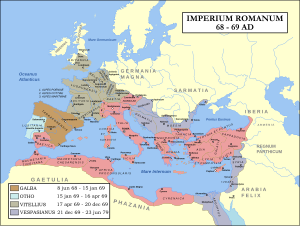| Millennium: | 1st millennium |
|---|---|
| Centuries: | |
| Decades: | |
| Years: |
| AD 69 by topic |
|---|
| Leaders |
| Categories |
| Gregorian calendar | AD 69 LXIX |
| Ab urbe condita | 822 |
| Assyrian calendar | 4819 |
| Balinese saka calendar | N/A |
| Bengali calendar | −524 |
| Berber calendar | 1019 |
| Buddhist calendar | 613 |
| Burmese calendar | −569 |
| Byzantine calendar | 5577–5578 |
| Chinese calendar | 戊辰年 (Earth Dragon) 2766 or 2559 — to — 己巳年 (Earth Snake) 2767 or 2560 |
| Coptic calendar | −215 – −214 |
| Discordian calendar | 1235 |
| Ethiopian calendar | 61–62 |
| Hebrew calendar | 3829–3830 |
| Hindu calendars | |
| - Vikram Samvat | 125–126 |
| - Shaka Samvat | N/A |
| - Kali Yuga | 3169–3170 |
| Holocene calendar | 10069 |
| Iranian calendar | 553 BP – 552 BP |
| Islamic calendar | 570 BH – 569 BH |
| Javanese calendar | N/A |
| Julian calendar | AD 69 LXIX |
| Korean calendar | 2402 |
| Minguo calendar | 1843 before ROC 民前1843年 |
| Nanakshahi calendar | −1399 |
| Seleucid era | 380/381 AG |
| Thai solar calendar | 611–612 |
| Tibetan calendar | 阳土龙年 (male Earth-Dragon) 195 or −186 or −958 — to — 阴土蛇年 (female Earth-Snake) 196 or −185 or −957 |

AD 69 (LXIX) was a common year starting on Sunday (link will display the full calendar) of the Julian calendar. In the Roman Empire, it was known as the Year of the consulship of Galba and Vinius (or, less frequently, year 822 Ab urbe condita). The denomination AD 69 for this year has been used since the early medieval period, when the Anno Domini calendar era became the prevalent method in Europe for naming years.